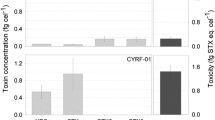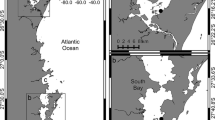Abstract
Concentrations of paralytic shellfish poisoning (PSP) toxins in toxic dinoflagellate cells and in marine planktonic copepods were monitored during the bloom of Alexandrium tamarense in Hiroshima Bay, western Japan. Concentration of the toxins retained by copepods was a function of the ambient toxin concentration, i.e. the product of A. tamarense cell density and cellular toxicity. The toxin concentration in copepods increased with the increase of toxicants in the seawater then leveled off, but decreased significantly at higher concentrations. In the field, the maximum toxin concentration was 1.2 pmol ind-1, whereas in the laboratory, the copepod Acartia omorii accumulated a much higher concentration of PSP toxins (24 pmol ind-1). Feeding avoidance against Alexandrium tamarense and a shift to alternative food sources such as diatoms in the field might keep their toxin levels lower than their potentially maximum level. The copepod toxin levels in the field were not so high as to cause an instantaneous lethal effect on their predator fishes but may reach possibly lethal levels after a few days' continuous feeding. Overall toxin retention by copepods after 12 h feeding and 2 h starvation was only 2.5% of total ingested toxins, which suggested that a significant amount of toxins was released into the seawater. Measurements of toxin reduction and gut evacuation suggested that the toxins were removed through both fecal evacuation and metabolism (e.g. excretion, decomposition and transformation). The results, as a whole, imply that copepods can be a link for PSP toxin flux in both pelagic and benthic food webs and can also be a sink for toxins by metabolizing and removing them from the environment.






Similar content being viewed by others
References
Anderson DM, White AW (1992) Marine biotoxins at the top of the food chain. Oceanus 35:55–61
AOAC (1984) Paralytic shellfish poison: biological method. In: Williams S (ed) Official methods of analysis. Association of Official Analytical Chemists, Arlington, Va., pp 344–345
Asakawa M, Miyazawa K, Noguchi T (1993) Studies on paralytic shellfish poison (PSP) toxification of bivalves, in association with appearance of Alexandrium tamarense, in Hiroshima Bay, Hiroshima prefecture. J Food Hyg Soc Jpn 34:50–54
Asakawa M, Miyazawa K, Takayama H, Noguchi T (1995) Dinoflagellate Alexandrium tamarense as the source of paralytic shellfish poison (PSP) contained in bivalves from Hiroshima Bay, Hiroshima prefecture, Japan. Toxicon 33:691–697
Asakawa M, Nishimura F, Miyazawa K, Noguchi T (1997) Occurrence of paralytic shellfish poison in the starfish Asterias amurensis in Kure Bay, Hiroshima prefecture, Japan. Toxicon 35:1081–1087
Bagoien E, Miranda A, Reguera B, Franco JM (1996) Effects of two paralytic shellfish toxins producing dinoflagellates on the pelagic harpacticoid copepod Euterpina acutifrons. Mar Biol 126:361–369
Boyer GL, Sullivan JJ, LeBlanc M, Anderson RJ (1985) The assimilation of PSP toxins by the copepod Tigriopus californicus from dietary Protogonyaulux catenella. In: Anderson DM, White AW, Baden DH (eds) Toxic dinoflagellates. Elsevier, Amsterdam, pp 407–412
Dutz J (1998) Repression of fecundity in the neritic copepod Acartia clausi exposed to the toxic dinoflagellate Alexandrium lusitanicum: relationship between feeding and egg production. Mar Ecol Prog Ser 175:97–107
Fushimi T (1975) Diet (in Japanese). In: The Japanese Society of Fisheries Science (ed) Feeding and growth of juvenile fishes. Kouseisha-Kouseikaku, Tokyo, pp 67–83
Geraci JR, Anderson DA, Timperi RJ, Aubin DJS, Early GA, Prescott JH, Mayo CA (1989) Humpback whales (Megaptera novaeangliae) fatally poisoned by dinoflagellate toxin. Can J Fish Aquat Sci 46:1895–1898
Gill CW, Harris RP (1987) Behavioural response of the copepods Calanus helgolandicus and Temora longicornis to dinoflagellate diets. J Mar Biol Assoc UK 67:785–801
Guisande C, Frangopulos M, Maneiro I, Vergara AR, Riveiro I (2002a) Ecological advantages of toxin production by the dinoflagellate Alexandrium minutum under phosphorus limitation. Mar Ecol Prog Ser 225:169–176
Guisande C, Frangopulos M, Carotenuto Y, Maneiro I, Riveiro I, Vergara AR (2002b) Fate of paralytic shellfish poisoning toxins ingested by the copepod Acartia clausi. Mar Ecol Prog Ser 240:105–115
Hallegraeff GM (1993) A review of harmful algal blooms and their apparent global increase. Phycologia 32:79-99
Hamasaki K, Horie M, Tokimitsu S, Taguchi S (2001) Variability in toxicity of the dinoflagellate Alexandrium tamarense isolated from Hiroshima Bay, western Japan, as a reflection of changing environmental conditions. J Plankton Res 23:271–278
Harrison PJ, Yu PW, Thompson PA, Price NM, Phillips DJ (1988) Survey of selenium requirements in marine phytoplankton. Mar Ecol Prog Ser 47:89–96
Holm-Hansen O, Lorenzen CJ, Holems RW, Strickland JDH (1965) Fluorometric determination of chlorophyll. J Cons Int Explor Mer 30:3–15
Ito K, Asakawa M, Shida Y, Miyazawa K (2003) Occurrence of paralytic shellfish poison (PSP) in the starfish Asterias pectinifera collected from the Kure Bay, Hiroshima prefecture, Japan. Toxicon 41:291–295
Ives JD (1985) The relationship between Gonyaulax tamarensis cell toxin levels and copepod ingestion rates. In Anderson DM, White AW, Baden DH (eds) Toxic dinoflagellates. Elsevier, Amsterdam, pp 413–418
Ives JD (1987) Possible mechanisms underlying copepod grazing responses to levels of toxicity in red tide dinoflagellates. J Exp Mar Biol Ecol 112:131–145
Loeblich AR III (1975) A seawater medium for dinoflagellates and the nutrition of Cachonina niei. J Phycol 11:80–86
Maneiro I, Frangopulos M, Guisande C, Fernandez M, Reguera B, Riveiro I (2000) Zooplankton as a potential vector of diarrhetic shellfish poisoning toxins through the food web. Mar Ecol Prog Ser 201:155–163
Nagashima Y, Maruyama J, Noguchi T, Hashimoto K (1987) Analysis of paralytic shellfish poison and tetrodotoxin by ion-pairing high performance liquid chromatography. Nippon Suisan Gakkai Shi 53:819–823
Nagashima Y, Arakawa O, Shiomi, K, Noguchi T (1995) Paralytic shellfish poisons of ormer, Haliotis tuberculata, from Spain. J Food Hyg Soc Jpn 36:627–631
Oshima Y (1995) Post-column derivatization HPLC methods for paralytic shellfish poisons. In: Hallegraeff GM, Anderson DM, Cembella AD (eds) Manual on harmful marine microalgae. UNESCO, Paris, pp 81–94
Robineau B, Gagné JA, Fortier L, Cembella AD (1991) Potential impact of a toxic dinoflagellate (Alexandrium excavatum) bloom in survival of fish and crustacean larvae. Mar Biol 108:293–301
Saito T, Noguchi T, Takeuchi T, Kamimura S, Hashimoto K (1985) Ichthyotoxicity of paralytic shellfish poison. Bull Jpn Soc Sci Fish 51:257–260
Shumway SE (1990) A review of the effects of algal blooms on shellfish and aquaculture. J World Aquacult Soc 21:65–105
Teegarden GJ (1999) Copepod grazing selection and particle discrimination on the basis of PSP toxin content. Mar Ecol Prog Ser 181:163–176
Teegarden GJ, Cembella AD (1996) Grazing of toxic dinoflagellates, Alexandrium spp., by adult copepods of coastal marine: implications for the fate of paralytic shellfish toxins in marine food webs. J Exp Mar Biol Ecol 196:145–176
Turner JT, Tester PA (1997) Toxic marine phytoplankton, zooplankton grazers, and pelagic food webs. Limnol Oceanogr 42:1203–1214
Turner JT, Douccette GJ, Powell CL, Kulis DM, Kaefer BA, Anderson DM (2000) Accumulation of red tide toxins in large size fractions of zooplankton assemblages from Massachusetts Bay, USA. Mar Ecol Prog Ser 203:95–107
Turriff NJ, Runge JA, Cembella AD (1995) Toxin accumulation and feeding behaviour of the planktonic copepod Calanus finmarchicus exposed to the red-tide dinoflagellate Alexandrium excavatum. Mar Biol 123:55–64
Uye S, Takamatsu K (1990) Feeding interactions between planktonic copepods and red-tide flagellates from Japanese coastal waters. Mar Ecol Prog Ser 59:97–107
White AW (1977) Dinoflagellate toxins as probable cause of an Atlantic herring (Clupea harengus harengus) kill, and pteropods as apparent vector. J Fish Res Bd Can 34:2421–2424
White AW (1980) Recurrence of kills of Atlantic herring (Clupea harengus harengus) caused by dinoflagellate toxins transferred through herbivorous zooplankton. Can J Fish Aquat Sci 37:2262–2265
White AW (1981a) Marine zooplankton can accumulate and retain dinoflagellate toxins and cause fish kills. Limnol Oceanogr 26:103–109
White AW (1981b) Sensitivity of marine fishes to toxins from the red-tide dinoflagellate Gonyaulax excavata and implications for fish kills. Mar Biol 65:255–260
Acknowledgements
We wish to acknowledge Dr. H. Takayama and Mr. S. Aida of Hiroshima Prefectural Fisheries Experimental Station for providing the isolated strain of Alexandrium tamarense and access to the light trapping copepod sampler, respectively. We also thank Dr. Y Nagashima for generously providing a PSP toxins standard. We are grateful to Dr. D. Checkley and Dr. L. A. Long for their helpful comments on this manuscript. This work was supported in part by Grant-in-Aid (Nos. 10760116 and 12NP0201) from the Ministry of Education, Science, Grant-in-Aid for Exploratory Research (Nos. 14656077 and14656129) from The Japan Society for the Promotion of Science and a grant from Culture of Japan and Regional Science Promoting Program of Hiroshima Industrial Technology Organization.
Author information
Authors and Affiliations
Corresponding author
Additional information
Communicated by T. Ikeda, Hakodate
Rights and permissions
About this article
Cite this article
Hamasaki, K., Takahashi, T. & Uye, Si. Accumulation of paralytic shellfish poisoning toxins in planktonic copepods during a bloom of the toxic dinoflagellate Alexandrium tamarense in Hiroshima Bay, western Japan. Marine Biology 143, 981–988 (2003). https://doi.org/10.1007/s00227-003-1131-7
Received:
Accepted:
Published:
Issue Date:
DOI: https://doi.org/10.1007/s00227-003-1131-7




